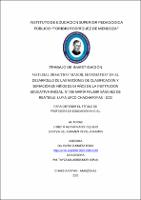| dc.contributor.advisor | Dra Zumaeta Rojas, Jovita | es_PE |
| dc.contributor.author | Altamirano Requejo, Lisbeth | es_PE |
| dc.contributor.author | Revilla Ramos, Eroyza Del Carmen | es_PE |
| dc.contributor.editor | Altamirano Requejo, Lisbeth | es_PE |
| dc.contributor.editor | Revilla Ramos, Eroyza Del Carmen | es_PE |
| dc.date.accessioned | 2025-06-23T16:38:42Z | |
| dc.date.available | 2025-06-23T16:38:42Z | |
| dc.date.issued | 2023-12-29 | |
| dc.identifier.uri | http://hdl.handle.net/123456789/20 | |
| dc.description.abstract | The present research study began with the definition and formulation of the
problem: How does the use of the didactic material "mathematical apron" optimize the
development of the notions of classification and seriation in the children of 04 years
old of the Initial Educational Institution N° 006 María Palmir Sánchez de Reategui;
Luya Urco - 2023? Likewise, the general objective was. To analyze in what way the
didactic material "mathematical apron" optimizes the development of the notions of
classification and seriation, for which we worked with 25 children as a sample of study
of the "Ordered" section; also the type of study carried out was applicative -
explanatory. Therefore, the design used corresponded to a pre-experimental research,
called pre and post test; before and after its application to check if the established
purpose has been achieved according to the proposed objectives, concluding in the
following way: the application of didactic material: Mathematical apron, significantly
influenced the level of development of the notions of classification and seriation in the
children of 04 years old of the Initial Educational Institution N° 006 María Palmir
Sánchez de Reategui. Luya Urco - 2023, thus demonstrating the effectiveness of our
proposed objective.
Keywords: Teaching material: Mathematical apron, notion, classification and
serialization. | es_PE |
| dc.description.tableofcontents | PAGINA DEL JURADO ............................................................................................. ii
RESUMEN .................................................................................................................. iii
ABSTRACT ................................................................................................................ iv
DEDICATORIA .......................................................................................................... v
AGRADECIMIENTO ................................................................................................ vi
CAPITULO I
INTRODUCCIÓN ....................................................................................................... 1
1. PROBLEMA DE INVESTIGACIÓN ..................................................................... 3
1.1 Planteamiento del problema ......................................................................................3
1.2 Formulación del problema .........................................................................................5
1.2.1 Problema principal .................................................................................. 5
1.2.2 Problemas específicos ............................................................................. 5
1.3 Objetivos de la investigación ....................................................................................5
1.3.1 Objetivo general ...................................................................................... 5
1.3.2 Objetivos específicos ............................................................................... 6
1.4 Formulación de la hipótesis .......................................................................................6
1.4.1 Hipótesis general ..................................................................................... 6
1.4.2 Hipótesis específicas ............................................................................... 6
1.5 Justificación de la investigación ...............................................................................7
1.5.1 Teórica .................................................................................................... 7
1.5.2 Metodológica ........................................................................................... 7
1.5.3 Práctica .................................................................................................... 8
CAPITULO II
2. MARCO TEÓRICO ............................................................................................... 10
2.1 Antecedentes de la investigación ............................................................................10
2.1.1 A nivel internacional ............................................................................. 10
2.1.2 A nivel nacional .................................................................................... 10
2.1.3 A nivel regional y/o local ...................................................................... 12
2.2 Bases teóricas ............................................................................................................13
2.2.1 Materiales didácticos ............................................................................. 13
2.2.1.1 Selección de los materiales didácticos ...................................... 14
2.2.2 Dimensiones de los materiales didácticos ................................... 15
2.2.3 Objetivos de los materiales didácticos ......................................... 16
2.2.4 Función de los materiales didácticos ........................................... 16
2.2.5 Teoría cognitiva de Piaget ........................................................... 18
2.2.6 Teoría del constructivismo de Lev Vygotsky .............................. 18
2.3 Clasificación y seriación ..........................................................................................19
2.3.1 Clasificación .......................................................................................... 19
2.3.1.1 Estadios de la clasificación ....................................................... 20
2.3.2 Colección no figural ..................................................................... 21
2.3.3 Seriación ...................................................................................... 21
2.3.3.1 Principios de la seriación ................................................. 22
2.3.4 Teoría del aprendizaje por descubrimiento. ....................... 22
2.3.5 Teoría del aprendizaje significativo ................................... 23
2.4 Definición de términos básicos ...............................................................................23
CAPITULO III
3. METODOLOGÍA .................................................................................................. 35
3.1 Identificación de las variables de investigación ...................................................35
3.2 Tipo, nivel y diseño de la investigación ................................................................38
3.2.1 Tipo y nivel ........................................................................................... 38
3.3 Diseño de investigación ................................................................................... 39
3.4 Población y muestra ........................................................................................ 40
3.4.1 Población ....................................................................................................... 40
3.4.2 Muestra ........................................................................................................... 41
3.5 Técnicas e instrumentos de recolección de datos .................................................42
3.5.1 Técnicas ......................................................................................................... 42
3.5.2 Observación ................................................................................................... 42
3.5.3 Instrumentos .................................................................................................. 42
3.5.3.1 Lista de cotejo ........................................................................... 42
3.5.3.2 Rúbrica ...................................................................................... 43
3.6 Procesos de prueba de hipótesis y análisis de datos .............................................43
3.6.1 Métodos teóricos ................................................................................... 44
3.6.1.1 Inducción – deducción .............................................................. 44
3.6.1.2 Análisis – síntesis ..................................................................... 45
3.6.2 Media .................................................................................................. 45
3.6.3 Mediana .......................................................................................................... 45
3.6.4. Moda .......................................................................................................... 46
CAPITULO IV
4. DESCRIPCIÓN DE LOS ANÁLISIS Y RESULTADOS..................................... 48
4.1 Resultados: tablas estadísticas y gráficos PRE – TEST y POS – TEST ...........48
4.2 Resultados PRE – TEST y POS – TEST: Nivel de desarrollo de las nociones
de clasificación y seriación en los niños de 04 años de la I.E.I N° 006 María
Palmir Sánchez de Reátegui. Luya Urco - Chachapoyas - 2023. ......................52
CAPITULO V
5. DISCUSIÓN CONCLUSIONES Y RESULTADOS ............................................ 55
DISCUSIÓN .............................................................................................................. 55
CONCLUSIONES ..................................................................................................... 58
RECOMENDACIONES ............................................................................................ 59
REFERENCIAS BIBLIOGRÁFICAS ....................................................................... 60 | es_PE |
| dc.format | application/pdf | es_PE |
| dc.language.iso | spa | es_PE |
| dc.relation | MATERIAL DIDÁCTICO “MANDIL MATEMÁTICO” EN EL DESARROLLO DE LAS NOCIONES DE CLASIFICACIÓN Y SERIACIÓN EN NIÑOS DE 04 AÑOS DE LA INSTITUCIÓN EDUCATIVA INICIAL. N° 006 MARÍA PALMIR SÁNCHEZ DE REÁTEGUI. LUYA URCO-CHACHAPOYAS - 2023 | es_PE |
| dc.relation.uri | Investigación | es_PE |
| dc.rights | info:eu-repo/semantics/openAccess | es_PE |
| dc.subject | Investigación | es_PE |
| dc.title | MATERIAL DIDÁCTICO “MANDIL MATEMÁTICO” EN EL DESARROLLO DE LAS NOCIONES DE CLASIFICACIÓN Y SERIACIÓN EN NIÑOS DE 04 AÑOS DE LA INSTITUCIÓN EDUCATIVA INICIAL. N° 006 MARÍA PALMIR SÁNCHEZ DE REÁTEGUI. LUYA URCO-CHACHAPOYAS - 2023 | es_PE |
| dc.type | info:eu-repo/semantics/bachelorThesis | es_PE |
| dc.type.version | info:eu-repo/semantics/publishedVersion | es_PE |
| dc.publisher.country | PE | es_PE |
| dc.subject.ocde | https://purl.org/pe-repo/ocde/ford#5.03.02 | es_PE |
| renati.author.dni | 77425471 | |
| renati.author.dni | 46716400 | |
| renati.advisor.orcid | https://orcid.org/0000-0002-4580-6169 | es_PE |
| renati.advisor.dni | 40107844 | |
| renati.type | https://purl.org/pe-repo/renati/type#trabajoDeInvestigacion | es_PE |
| renati.level | https://purl.org/pe-repo/renati/nivel#tituloProfesional | es_PE |
| renati.juror | P: Tafur Angulo, Julio | es_PE |
| renati.juror | S: Iglesias Mendoza, Yulisa | es_PE |
| renati.juror | V: Cabañas Melendez, Deicy Eugenia | es_PE |
| thesis.degree.name | Profesora en Educación Inicial | es_PE |
| thesis.degree.grantor | Instituto de Educación Superior Publico "Pedagógico Toribio Rodríguez de Mendoza" | es_PE |


